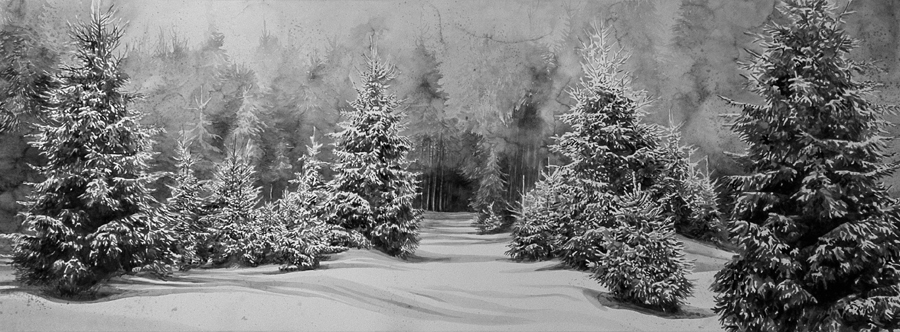Let’s start with a small confession. When visiting art fairs like Artissima in Turin, Art Dubai or Art Brussels, I’ve often come across watercolours by the internationally known Belgian artist Hans Op de Beeck. When seeing these works on paper, which look a bit scholarly, lightly romantic and sometimes annoyingly would-be poetic, I couldn’t help thinking: this is the kind of stuff that pleases collectors for its gentle recognisability, by an artist who, in between bigger projects, makes such things to finance his more interesting and ambitious pieces. (These, in Op de Beeck’s case, include immersive installations, sculptures, videos, novels, the set design for Gluck’s 1762 opera Orphée et Eurydice directed by Frédéric Flamand and a play he is currently working on and will direct for the Schauspiel in Frankfurt.) So upon hearing that the Botanique wanted to dedicate an entire show to these works on paper – not exactly the strongest section of the artist’s varied production – I started having doubts.
Botanique, a concert venue with an exhibition hall, does not have natural light in its show spaces – a condition that triggered Op de Beeck to show his watercolours, which he makes alone, at night, when his army of assistants has gone home. If a feeling of solitude is also present in the lifesize installations and videos he’s best known for, it registers more strongly here, perhaps due to the work’s isolated creative process. It is exactly that sense of melancholia Op de Beeck manages to transfer to the scenography of his exhibition, which o¡ers a kind of retreat in the middle of a lively music venue. The exhibition space has been darkened, the drawings are scarcely lit, the walls are painted grey and a soft carpet mutes visitors’ footsteps. Op de Beeck is clearly a master of scene setting, as previously illustrated with his fine installations of, for example, the deserted highway restaurant in Location (5) (2004). Here, he adeptly plunges the spectator into his universe, inviting him/her to an internal journey. At the same time, though, the question arises: would these watercolours also work on their own merits in a less-poetic setting?
It’s clearly not via these works’ subject matter that Op de Beeck gains points for originality: the drawings depict a flock of birds, the sea (in three di¡erent formats), landscapes with or without snow, a cat… The artist seems to have a penchant for stereotypes. But unlike some of his contemporaries, he does not tackle these with the slightest irony or make pastiches from them. He is bloody serious. He uses tropes and easy metaphors for solitude, like a deserted highrise city lit at night, as if they had never been done before. Op de Beeck can make beautiful watercolours, fair enough, but he lacks imagination, and his work often borders dangerously on the banal. A handful of these surpass that problem (like the mysterious lady in a cheongsam, Dress (2), all works 2014) or the cropped depiction of a woman’s leather boots (Black Boots), but most don’t. Sometimes the work becomes pure kitsch: like the reflected image of a nude in front of a house (The Theatre Stage) or a woman wearing a raincoat and carrying suitcases, ready to leave everything behind (Window), the kind of scene that could be used for the cover of a pulp novel. It goes to show that these works, even the better ones, do have a strong illustrative and anecdotal side.
Op de Beeck’s watercolours are also brought alive in the animated video Night Time, a kind of slideshow of images of melancholia. Though some of these works are beautiful, as a whole this is a bit lame, predictable and lacking in substance, like the show as a whole. If you want to show watercolours nowadays, you have to come up with a personal and original style or at least an amazing technique. Op de Beeck does neither. While the soft sense of poetry that characterises his installations and videos may appeal, on paper it easily becomes cheesy and predictable. In this pure and honest medium, there is no way to hide.
This article was first published in the January & February 2015 issue.
